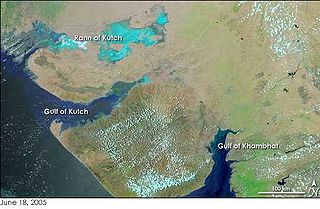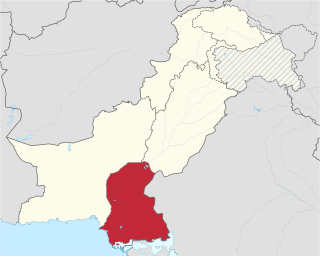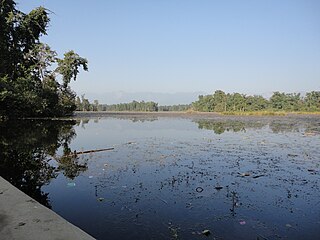
The Great Rann of Kutch is a salt marsh in the Thar Desert in the Kutch District of Gujarat, India. It is about 7500 km2 in area and is reputed to be one of the largest salt deserts in the world. This area has been inhabited by the Kutchi people.

The mugger crocodile is a medium-sized broad-snouted crocodile, also known as mugger and marsh crocodile. It is native to freshwater habitats from southern Iran to the Indian subcontinent, where it inhabits marshes, lakes, rivers and artificial ponds. It rarely reaches a body length of 5 m and is a powerful swimmer, but also walks on land in search of suitable waterbodies during the hot season. Both young and adult mugger crocodiles dig burrows to which they retreat when the ambient temperature drops below 5 °C (41 °F) or exceeds 38 °C (100 °F). Females dig holes in the sand as nesting sites and lay up to 46 eggs during the dry season. The sex of hatchlings depends on temperature during incubation. Both parents protect the young for up to one year. They feed on insects, and adults prey on fish, reptiles, birds and mammals.

Bhitarkanika National Park is a 145 km2 (56 sq mi) national park in northeast Kendrapara district in Odisha in eastern India. It was designated on 16 September 1998 and obtained the status of a Ramsar site on 19 August 2002. The area is also been designated as the second Ramsar site of the State after the Chilika Lake. It is surrounded by Bhitarkanika Wildlife Sanctuary, which spread over 672 km2 (259 sq mi). Gahirmatha Beach and Marine Sanctuary are to the east, separating the swamp region and mangroves from the Bay of Bengal. The national park and wildlife sanctuary is inundated by the rivers Brahmani, Baitarani, Dhamra, and Pathsala. It hosts many mangrove species, and is the second largest mangrove ecosystem in India.
Nara Desert Wildlife Sanctuary is located in Mirpur Khas District, Sindh, Pakistan.
The Rann of Kutch Wildlife Sanctuary is the largest Ramsar site in Sindh, covering 566,375 ha, and is located in the Rann of Kutch in Badin District, Sindh, Pakistan. In 1980, declared as a wildlife sanctuary by the Government of Sindh, the Rann of Kutch covers the most Ramsar site area as compared to that of any other of the ten Ramsar sites in Sindh province of Pakistan.

Kota Kinabalu Wetland Centre is 24 hectares of the only remains of mangrove forest that once existed extensively along the coastal region of Kota Kinabalu, Malaysia. Previously known as Likas Swamp or Likas Mangrove and later Kota Kinabalu City Bird Sanctuary, the Centre came foremost out of 20 wetlands selected by the Sabah Wetlands Inventory Committee in 1986.

The wildlife of Pakistan comprises a diverse flora and fauna in a wide range of habitats from sea level to high elevation areas in the mountains, including 195 mammal, 668 bird species and more than 5000 species of Invertebrates. This diverse composition of the country's fauna is associated with its location in the transitional zone between two major zoogeographical regions, the Palearctic, and the Oriental. The northern regions of Pakistan, which include Khyber Pakhtunkhwa and Gilgit Baltistan include portions of two biodiversity hotspot, Mountains of Central Asia and Himalayas.

Pakistan's native fauna reflect its varied climatic zones. The northern Pakistan, which includes Khyber Pakhtunkhwa and Gilgit Baltistan, has portions of two biodiversity hotspots, Mountains of Central Asia and Himalayas.

The fauna of Sindh live in an area with a semi arid climate. With its coastal and riverine forests, its huge fresh water lakes, mountains and deserts, Sindh supports a large and varied wildlife population.

The Central Asian Flyway (CAF), Central Asian-Indian Flyway, or Central Asian-South Asian Flyway is a flyway covering a large continental area of Eurasia between the Arctic Ocean and the Indian Ocean and the associated island chains. The CAF comprises several important migration routes of waterbirds, most of which extend from the northernmost breeding grounds in Siberia to the southernmost non-breeding wintering grounds in West Asia, India, the Maldives and the British Indian Ocean Territory.

Bundala National Park is an internationally important wintering ground for migratory water birds in Sri Lanka. Bundala harbors 197 species of birds, the highlight being the greater flamingo, which migrate in large flocks. Bundala was designated a wildlife sanctuary in 1969 and redesignated to a national park on 4 January 1993. In 1991 Bundala became the first wetland to be declared as a Ramsar site in Sri Lanka. In 2005 the national park was designated as a biosphere reserve by UNESCO, the fourth biosphere reserve in Sri Lanka. The national park is situated 245 kilometres (152 mi) southeast of Colombo.
The Agusan Marsh Wildlife Sanctuary is a protected area in Agusan del Sur, Philippines declared by President Fidel V. Ramos. The marshland acts like a sponge, as it is nestled in the midwaters of the Agusan River drainage basin. Within its lakes, several floating communities can be found. The sanctuary was home to the 20.24 feet (6.17 m) saltwater crocodile Lolong, the world's largest captive crocodile.

Ghodaghodi Tal is a Ramsar site in western Nepal. It was established in August 2003 it covers an area of 2,563 h (9,230 ks) in Kailali District at an elevation of 205 m (673 ft) on the lower slopes of the Siwalik Hills. It was declared as a bird sanctuary in March 2022.

Bishazari Tal, also spelled Beeshazar Tal, is an extensive oxbow lake system in the buffer zone of the Chitwan National Park, a protected area in the Inner Terai of central Nepal. This wetland covers an area of 3,200 ha at an altitude of 286 m (938 ft). The Mahabharat mountain range is located north of the lake, which is itself north of the Siwalik Hills. In August 2003, it has been designated as a Ramsar site.
Three species of crocodilian are present in India. The mugger crocodile is found in lakes and rivers throughout the country. The saltwater crocodile is found along the eastern coast of the country and the Nicobar and Andaman Islands. The gharial is found in river areas, though is greatly reduced from its previous range. In the pre-historic period, seven species resided in India.

Bhor Saidan Crocodile Breeding Centre, managed by the Haryana Forests Department to captive breed and conserve the freshwater mugger crocodile native to India, is located at Bhor Saidan village on Kurukshetra-Pehowa Road in Kurukshetra district of Haryana in India. It is 13 km from the old Kurukshetra Bus Stand and 22 km from the new Kurukshetra Bus Stand in sector 10.
Vankalai Sanctuary, also known as the Mannar Bird Sanctuary, is located in the northwest of Sri Lanka in the Mannar District. This site covers an area of 4,839 ha.












